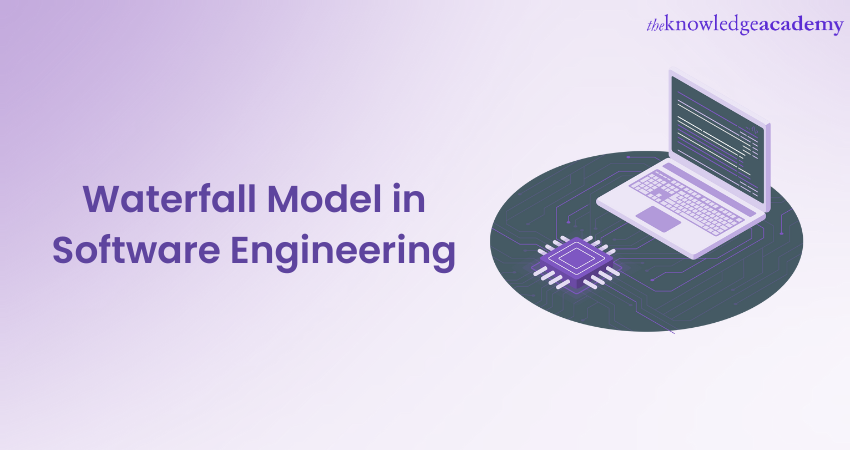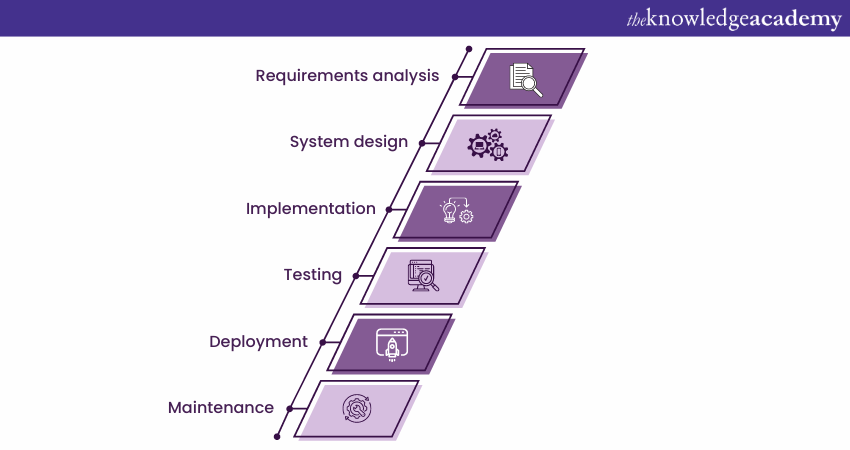We may not have the course you’re looking for. If you enquire or give us a call on 01344203999 and speak to our training experts, we may still be able to help with your training requirements.
Training Outcomes Within Your Budget!
We ensure quality, budget-alignment, and timely delivery by our expert instructors.

The Waterfall Model is a traditional and linear approach to software development that was widely used in the field of software engineering, particularly in the earlier days of the industry. It has marked a sequential journey through distinct phases ensuring clarity, predictability, and meticulous documentation.
The Waterfall Model in Software Engineering is a traditional and linear approach to Software Development that ensures systematic development for quality results. This blog comprehensively examines its phases, strengths, limitations, ideal scenarios, and real-world applications. Read below to know more.
Table of Contents
1) What is Waterfall Model in Software Engineering
2) Phases of the Waterfall Model
a) Requirements analysis
b) System design
c) Implementation
d) Testing
e) Deployment
f) Maintenance
3) Advantages of the Waterfall Model
4) Limitations of the Waterfall Model
5) When to use the Waterfall Model
6) Conclusion
What is Waterfall Model in Software Engineering
The Waterfall Model is one of the linear Software Development approaches. It consists of sequential phases namely Requirements analysis, System design, Implementation, Testing, Deployment, and Maintenance. Each step builds upon the previous one, emphasising clear documentation, predictability, and stakeholder involvement. While offering structure and reliability, it can be inflexible in the face of changing requirements. This model suits projects with stable needs and regulatory demands. Notable instances include NASA's space shuttle software and healthcare systems.
Unlock your potential with our comprehensive Software Engineering Training by embarking on a journey of innovation and mastery today!
Phases of the Waterfall Model
The Waterfall Model features a sequence of well-defined phases that flow linearly like a descending waterfall. These phases establish a structured Software Development framework, ensuring each step's completion before proceeding to the next. Let us explore crucial phases in the Waterfall Model below:
Requirements analysis
This initial phase involves in-depth stakeholder communication to gather and document project requirements. These requirements encompass the software's functional and non-functional aspects, ensuring a comprehensive understanding of user needs and expectations.
System design
In this phase, the development team designs the software architecture based on the requirements, outlining system components, data flow, and interactions to create a comprehensive blueprint.
Implementation
The software's actual coding and programming occur in the implementation phase. Developers write code based on the design specifications, working collaboratively to ensure consistency and adherence to coding standards.
Testing
The software undergoes rigorous testing to identify and rectify defects or discrepancies. There are many testing methods, such as unit testing, integration testing, and system testing, to ensure the software's functionality, performance, and reliability.
Deployment
Now, we are ready to deploy the software. We deploy it to the target environment, allowing users to access it. At this stage, to facilitate a smooth transition and maximise software utilisation, offering user training and comprehensive documentation is considered.
Maintenance
The software requires ongoing maintenance and support. This phase involves addressing user feedback, making necessary updates, and resolving issues post-deployment. Maintenance ensures the software remains functional, up-to-date, and aligned with changing user needs and technological advancements.

Unlock the power of agility in Software Development by joining our Agile Software Development Training and elevate your skills today!
Advantages of the Waterfall Model
The Waterfall Model presents several distinct advantages in Software Development:
a) Clarity and structure: The model's sequential nature provides a clear roadmap, guiding developers through well-defined phases, enhancing project management, and minimising ambiguity.
b) Predictability: The linear progression allows for accurate project timelines and resource allocation, facilitating effective planning and execution.
c) Thorough documentation: Each phase demands comprehensive documentation, ensuring a detailed record of requirements, design, and implementation, which aids in future maintenance and upgrades.
d) Stakeholder involvement: Early requirement gathering promotes stakeholder engagement, reducing misunderstandings, and aligning the final product with user expectations.
e) Quality assurance: Rigorous testing at multiple stages enhances the likelihood of detecting and rectifying defects, resulting in a more reliable and robust product.
f) Regulatory compliance: Industries with strict regulatory requirements benefit from the model's systematic documentation, aiding compliance verification.
Limitations of the Waterfall Model
While the Waterfall Model offers notable benefits, it is not without limitations:
a) Inflexibility: The sequential nature can hinder adaptation to changing requirements or unexpected developments, potentially leading to project delays or suboptimal solutions.
b) Late feedback incorporation: Stakeholders often only see the product during testing or deployment, making it challenging to incorporate their feedback effectively, increasing the risk of misaligned expectations.
c) Risk of failure: If initial requirements are accurate or complete, the project may continue, requiring substantial revisions or abandonment.
d) Long delivery time: The linear progression may result in longer development cycles, particularly for complex projects, delaying the availability of the final product.
e) Limited iteration: Unlike iterative methodologies, the Waterfall Model lacks built-in iterations, reducing opportunities for refinement and enhancement after the initial design phase.
f) Dependency on documentation: Relying heavily on documentation can lead to a disconnect between the documented plan and the actual needs, causing inefficiencies and errors.
Embrace agility and elevate your skills with our Agile Software Development Training.Unlock the potential of efficient, collaborative, and innovative Software Development.
When to use the Waterfall Model
The Waterfall Model is suited for projects characterised by stable and well-defined requirements where changes are unlikely to occur.
a) Stable requirements: Projects have well-defined and stable requirements that are unlikely to change significantly throughout development.
b) Clear documentation: Detailed documentation is crucial, such as in industries with regulatory compliance or where comprehensive records are necessary.
c) Predictable timelines: The project benefits from a clear, sequential roadmap, ensuring accurate timelines and resource allocation.
d) Limited coordination: Smaller teams with less need for constant coordination can effectively follow the linear progression of the model.
e) Established processes: Industries with established processes and a preference for clear milestones, like Aerospace or Healthcare, find alignment with the Waterfall Model.
f) Critical systems: Development of critical systems where reliability, safety, and thorough planning are paramount, such as medical device software.

Conclusion
The Waterfall Model in Software Engineering structured approach offers clarity, predictability, and documentation benefits. It suits stable projects with defined requirements, especially in regulated industries. Yet, its inflexibility and potential late-stage misalignments underscore the importance of selecting methodologies tailored to project dynamics, promoting successful Software Development in an ever-changing landscape.







 Top Rated Course
Top Rated Course



 If you wish to make any changes to your course, please
If you wish to make any changes to your course, please


